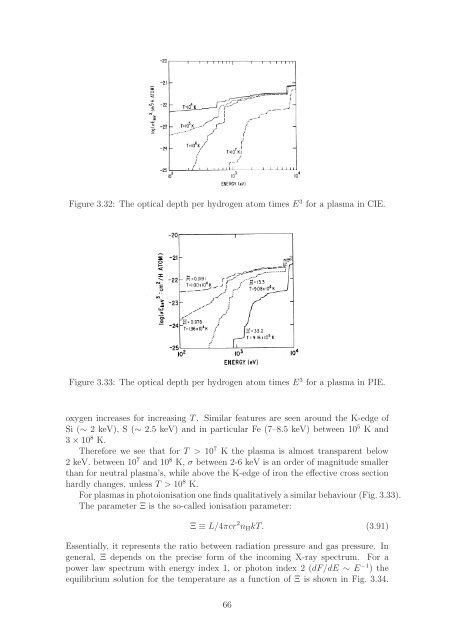Thermal X-ray radiation (PDF) - SRON
Thermal X-ray radiation (PDF) - SRON
Thermal X-ray radiation (PDF) - SRON
Create successful ePaper yourself
Turn your PDF publications into a flip-book with our unique Google optimized e-Paper software.
Figure 3.32: The optical depth per hydrogen atom times E 3 for a plasma in CIE.<br />
Figure 3.33: The optical depth per hydrogen atom times E 3 for a plasma in PIE.<br />
oxygen increases for increasing T. Similar features are seen around the K-edge of<br />
Si (∼ 2 keV), S (∼ 2.5 keV) and in particular Fe (7–8.5 keV) between 10 5 K and<br />
3 × 10 8 K.<br />
Therefore we see that for T > 10 7 K the plasma is almost transparent below<br />
2 keV. between 10 7 and 10 8 K, σ between 2-6 keV is an order of magnitude smaller<br />
than for neutral plasma’s, while above the K-edge of iron the effective cross section<br />
hardly changes, unless T > 10 8 K.<br />
For plasmas in photoionisation one finds qualitatively a similar behaviour (Fig. 3.33).<br />
The parameter Ξ is the so-called ionisation parameter:<br />
Ξ ≡ L/4πcr 2 n H kT. (3.91)<br />
Essentially, it represents the ratio between <strong>radiation</strong> pressure and gas pressure. In<br />
general, Ξ depends on the precise form of the incoming X-<strong>ray</strong> spectrum. For a<br />
power law spectrum with energy index 1, or photon index 2 (dF/dE ∼ E −1 ) the<br />
equilibrium solution for the temperature as a function of Ξ is shown in Fig. 3.34.<br />
66
















